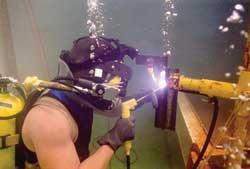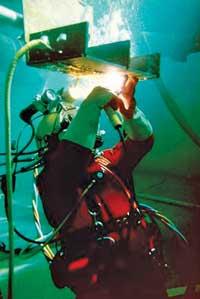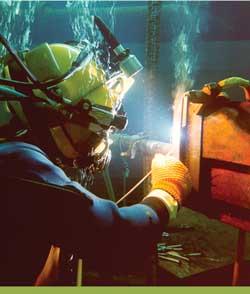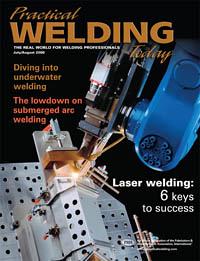- FMA
- The Fabricator
- FABTECH
- Canadian Metalworking
Categories
- Additive Manufacturing
- Aluminum Welding
- Arc Welding
- Assembly and Joining
- Automation and Robotics
- Bending and Forming
- Consumables
- Cutting and Weld Prep
- Electric Vehicles
- En Español
- Finishing
- Hydroforming
- Laser Cutting
- Laser Welding
- Machining
- Manufacturing Software
- Materials Handling
- Metals/Materials
- Oxyfuel Cutting
- Plasma Cutting
- Power Tools
- Punching and Other Holemaking
- Roll Forming
- Safety
- Sawing
- Shearing
- Shop Management
- Testing and Measuring
- Tube and Pipe Fabrication
- Tube and Pipe Production
- Waterjet Cutting
Industry Directory
Webcasts
Podcasts
FAB 40
Advertise
Subscribe
Account Login
Search
Underwater welding: Setting standards
Maintaining and repairing the world's largest ships
- Updated December 6, 2023
- July 29, 2008
- Article
- Arc Welding
Globe-trotting to places like Rio and Curaçao sounds like an adventure out of a spy movie. It's actually just another day at work for the underwater welding pros at Miami Diver Inc., Miami. Miami Diver and its partners in the SubSea Solutions Alliance specialize in the underwater inspection, maintenance, and repair of deep-sea vessels. The company has pioneered methods that make it one of the leading underwater welding outfits in the world.
Traveling at a moment's notice to any port in the world means Miami Diver's equipment needs to be compact enough to travel easily and able to use any input power anywhere in the world without sacrificing performance.
Setting Standards for Underwater Welding (Literally)
Underwater welding can be done in either a wet or dry environment, and Miami Diver excels at both. Wet welding involves using the power source's shielded metal arc welding (SMAW) capabilities with a special underwater electrode (Hydroweld FS™). The special flux that covers the electrode provides enough protection to lay a weld to code specifications even in water (see Figure 1). Dry underwater welding involves installing a cofferdam or hyperbaric chamber around the spot of the repair and pumping it dry. This allows a welder to make the repair in dry conditions.
Welding repairs to large ocean liners and oil platforms are a fact of life for shipping companies that operate on the high seas. But the cost in time, expense, and lost revenue is too high for the ship or platform to travel to a dry dock each time it needs repair. Miami Diver serves these companies by going to them whenever underwater welds are needed.
"We work only on deep-sea vessels," says Kevin Peters, president, Miami Diver. "Our operation breaks down into three aspects: inspection, maintenance, and repair. When you get into the high-end repair, that's where we really excel. And that includes the fact that we're the only company to date with an A-class wet weld procedure in accordance with D3.6 code."
The wet weld procedure Peters referred to is held to AWS standards under D3.6, "Specification for Underwater Welding," which is broken down into four classes: A, B, C, and O. In addition to AWS codes, each welding procedure is dictated by shipping societies throughout the world, none of which would approve wet welding on a ship as a permanent fix. Every weld is considered temporary and results in a "condition" being placed on the ship. A condition means that the weld must be replaced permanently when the ship arrives in dry dock. Ships are not granted new charters if a condition is placed on it.
Working with Hydroweld and XMT® 350 and XMT 456 multiprocess inverters from Miller Electric Mfg. Co., Miami Diver and its partners in the alliance were able to create approved procedures for Class-A welds "intended to be suitable for applications and design stresses comparable to their conventional surface welding counterparts by virtue of specifying comparable properties and testing requirements" that are considered permanent. This means the ship does not need to return to dry dock for a better repair and all conditions are lifted. This advance saves shipping companies a lot of money, and Miami Diver counts on the inverters to provide the weld consistency and quality to pull it all off.
Inverters Anchor Underwater Weld Procedure
The bulk of Miami Diver's underwater welding involves fillet welds on mild steel plate in thicknesses from ¼ inch to 1 in. Mild steel is required in underwater applications because of its low carbon content (a carbon content more than 0.4 percent will lead to hydrogen cracking underwater). Procedures include hull repair, stern seal replacement, bow thruster removal and replacement, and propeller blade changeouts.
The wet weldability of the material is determined by the carbon equivalent (CE). The generally accepted upper limit is 0.4 percent as calculated from a chemical or ladle analysis using either the long or shorter formula as detailed in AWS D3.6M:1999. When the CE is outside the upper limit, then other options may be considered, such as using a cofferdam or hyperbaric chamber. In this case, the cofferdam is wet-welded to the side of the ship, then dewatered to provide a dry environment for the welders.
In either case, the power source is located above water and is controlled by an operator stationed with the machine. Divers wear a helmet that is connected to the surface that provides air and communications with the operator and fellow divers. They descend with their welding or gouging leads and go to work (see Figure 2).

FIGURE 1. A welder uses an electrode that has a special flux covering that provides enough protection to lay down a code-compliant bead underwater.
This process presents numerous challenges. First, input power changes throughout the world. Miami Diver has burned up machines after plugging them into higher voltage than the older machines could handle. Second, dirty input power (excessive equipment starting/running off of the same power source) causes fluctuations. Third, the distance between where the machine is plugged into input power and where the final weld is taking place sometimes can be extremely long, leading to power fluctuations. And last, running an electricity-based procedure underwater is inherently risky.
Miller's Auto-Line™ technology allows for any input voltage hookup (from 208 to 575 V) with no manual linking required. It uses a boost converter to boost primary power to a higher voltage. That voltage then charges a capacitor that stores and distributes the energy evenly and guarantees a consistent arc throughout the welding process.
"We use very long cables," said Peters. "Some of them are 200 feet by the time you reach the dive site. So wherever it is on the ship, you might have to string a cable a long distance. And to have a consistent current at the end of that rod, that's the main [benefit]."
"In comparison to a standard diesel-driven DC unit, [the XMTs] give you a 25 percent edge as far as quality of the weld," Peters said. "It makes a good welder a great welder and a mediocre one a good welder. The stability that we get from it is the main thing. Fluctuations for a welder on the surface may not be an issue because he'll just long- or short-arc it. But underwater it is critical because you must maintain a certain distance."
The steady arc makes it easier for the welder and results in a better weld with less cleanup or rework. The inverters also draw 25 percent less power at rated output than comparable models (350 amps at 60 percent duty cycle for the XMT 350 and 450 amps at 38 VDC, 100 percent duty cycle, for the 456). All of these efficiencies provide time and cost savings for Peters and his crews.
The XMT 456 also plays a key role in Miami Diver's underwater maintenance and repair. Using a process called hydroarc gouging (carbon arc gouging with water instead of air), Peters and his crews are able to cut, remove, and repair damaged pieces underwater with the same precision as on the surface.
"The underwater carbon arc gouging [hydroarc gouging] we do is actually quite critical because we are now able to remove the weld itself underwater and, with some grinding, put it back up, whereas traditional cutting equipment for underwater is quite messy and you will end up with a jagged edge that you can't weld back up."
Underwater Welding Safety
Safety is also a concern with underwater welding because, of course, electricity and water don't mix. To ensure the safety of his divers, Peters has outfitted the inverters with Miller's RHC-14 hand control. This option controls the current and contactor remotely so that the surface operator can cut the current as soon as the diver requests it.
"You have to break the current when you change a rod," explained Peters. "So you want to make it cold. The remote boxes shut that unit down internally to where you don't get any electricity out of the amps. It's very convenient. Then the diver tells him he's ready, he flips the switch, and now he's back welding."
In addition to the benefits of the inverters and Auto-Line technology, Peters and his welders count on the inverters' small size to help them get through foreign customs quickly and with minimal hassle. The 350 weighs 80 pounds and can be shipped as luggage with members of the crew to ensure that they get to work immediately upon arrival at the site.

FIGURE 2. The diver's helmet provides air and a means of communication with other divers and the power source operator, who is located above the water.
"In some of these countries it's almost like court to get the equipment out of customs," said Peters. "But you can fly with any number of bags as long as they are less than 100 pounds. So our welders are never separated from their machines. It's the response time. We can travel on a flight and actually go to work on arrival."
Peters also relies on the service he gets from Miller and TriGas representative Manny Rosales. The fact that both providers are international companies with partners throughout the world, just like Miami Diver, doesn't hurt, either.
"It's a 24-hour clock with these ships," said Peters, "and they are obviously in different time zones throughout the world. So we work with people that we like."
About the Publication
Related Companies
subscribe now

The Welder, formerly known as Practical Welding Today, is a showcase of the real people who make the products we use and work with every day. This magazine has served the welding community in North America well for more than 20 years.
start your free subscription- Stay connected from anywhere

Easily access valuable industry resources now with full access to the digital edition of The Fabricator.

Easily access valuable industry resources now with full access to the digital edition of The Welder.

Easily access valuable industry resources now with full access to the digital edition of The Tube and Pipe Journal.
- Podcasting
- Podcast:
- The Fabricator Podcast
- Published:
- 04/16/2024
- Running Time:
- 63:29
In this episode of The Fabricator Podcast, Caleb Chamberlain, co-founder and CEO of OSH Cut, discusses his company’s...
- Industry Events
16th Annual Safety Conference
- April 30 - May 1, 2024
- Elgin,
Pipe and Tube Conference
- May 21 - 22, 2024
- Omaha, NE
World-Class Roll Forming Workshop
- June 5 - 6, 2024
- Louisville, KY
Advanced Laser Application Workshop
- June 25 - 27, 2024
- Novi, MI
































